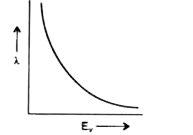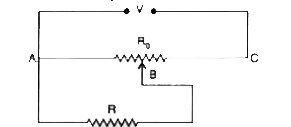X-rays fall on a photosensitive surface to cause photoelectric emission. Assuming that the work function of the surface can be neglected, find the relation between the de-Broglie wavelength () of the electrons emitted to the energy () of the incident photons. Draw the nature of the graph for as a function of .Solution in Kannada
As
Wavelength of emitted electrons ,

Topper's Solved these Questions
- BOOK - OSWAAL PUBLICATIONCHAPTER - DUAL NATURE OF RADIATION AND MATTEREXERCISE - TOPIC-2 DE-BROGLIE RELATION (SHORT ANSWER TYPE QUESTIONS-II)2videos
DUAL NATURE OF RADIATION AND MATTER
- BOOK - OSWAAL PUBLICATIONCHAPTER - DUAL NATURE OF RADIATION AND MATTEREXERCISE - TOPIC-2 DE-BROGLIE RELATION (LONG ANSWER TYPE QUESTIONS)1videos
DUAL NATURE OF RADIATION AND MATTER
- BOOK - OSWAAL PUBLICATIONCHAPTER - DUAL NATURE OF RADIATION AND MATTEREXERCISE - TOPIC-2 DE-BROGLIE RELATION (VERY SHORT ANSWER TYPE QUESTIONS)8videos
DUAL NATURE OF RADIATION AND MATTER
- BOOK - OSWAAL PUBLICATIONCHAPTER - CURRENT ELECTRICITY EXERCISE - TOPIC-3 (POTENTIOMETER & APPLICATIONS) (NUMERICAL PROBLEMS)2videos
CURRENT ELECTRICITY
- BOOK - OSWAAL PUBLICATIONCHAPTER - ELECTRIC CHARGES & FIELDSEXERCISE - (TOPIC -2)Numerical Problems5videos
ELECTRIC CHARGES & FIELDS
Similar Questions
An electron and a photon each have a wavelength of 1.00 nm. Find (i) their momentum (ii) the energy of the photon and (iii) K.E of electron
03:22View SolutionWhat are matter waves? Derive an expression for the de Broglie wave length.
03:39View SolutionA proton and an electron have same kinetic energy. Which one has smaller de-Broglie wavelength ?
02:55View SolutionA resistance of RΩ draws current from a potentiometer. The potentiometer has a total resistance R0Ω.A voltage V is supplied to the potentiometer. Derive an expression for the voltage across R when the sliding contact is in the middle of the potentiometer.
 02:48View Solution
02:48View SolutionAn atom was earlier assumed to be sphere of radius a having a positively charged point nucleus of charge +Ze at its centre . This nucleus was believed to be surrounded by a uniform desity of negative charge that made the atom neutral as a whole.
Use this theorem to find the electric field of this atom at a distance r(r>a) from the centre of the atom.04:08View SolutionX-rays of wavelength lambda fall on photosenstive surface, emitting electrons. Assuming that the work function of the surface can be neglected, prove that the de-broglie wavelength of electrons emitted will be sqrt((hlambda)/(2mc)) .
03:43View SolutionX-ray fall on a photosenstive surface to cause photoelectric emission. Assuming that the work function of the surface can be neglected, find the relation between the de -Broglie wavelength (λ) of the electrons emitted to the energy (Ev) of the incident photons. Draw the nature of the graph for λ as a function of Ev.
03:02View SolutionA photon of energy 2.5 eV and wavelenght lambda falls on a metal surface and the ejected electron have velocity 'v' . If the lambda of the incident light is decreased by 20% the maximum velocity of the emitted electrons is doubled. The work function of the metal is
01:18View SolutionIf λ0 is the threshold wavelength for photoelectric emission. λ wavelength of light falling on the surface on the surface of metal, and m mass of electron. Then de Broglie wavelength of emitted electron is :-
04:17View SolutionAn e-m wave of wavelength lambda is incident on a photo sensitive surface of negligible work function. If the photoelectrons emitted from this surface have the de-Broglie wavelength lambda_(1) . Find relation between 'lambda' and 'lambda_(1) '-
06:47View Solutionλ तरंगदैर्ध्य की X किरणे एक प्रकाश संवेदी प्रष्ट पर आपतित होती है प्रष्ट की कार्यफलन को नगड़िये मानते हुए सिद्ध किजीये की उत्सर्जित इलेक्ट्रान की डी ब्रोग्ली तरंगदैर्ध्य √hλ2mc है
03:22View SolutionA photon sensitive metallic surface emits electrons when X-rays of wavelength lambda fal on it. The de-Broglie wavelength of the emitted electrons is (Neglect the work function of the surface, m is mass of the electron. H=Planck's constant. C= velocity of light)
03:08View SolutionA photon of energy 2 E is incident on a photosensitive surface of photoelectric work function E. The maximum K.E. of photoelectron emitted is
03:44View SolutionX-rays of wavelength 'λ' fall on a photosensitive surface emitting electrons. Assuming that the work-function of the surface can be neglected, prove that the de Broglie wavelength of electrons emitted will be √hλ2mc
05:18View Solutionλ तरंगदैर्ध्य की X - किरणें एक प्रकाश सुग्राहक पृष्ठ (photo sensitive surface) पर आपतित होकर इलेक्ट्रॉनों का उत्सर्जन करती है | पृष्ठ के कार्यफलन को नगण्य (negligible) मानते हुए सिद्ध कीजिए कि उत्सर्जित इलेक्ट्रॉनों की डी - ब्रॉग्ली तरंगदैर्ध्य √hλ/(2mc) होगी |
07:09View Solution

